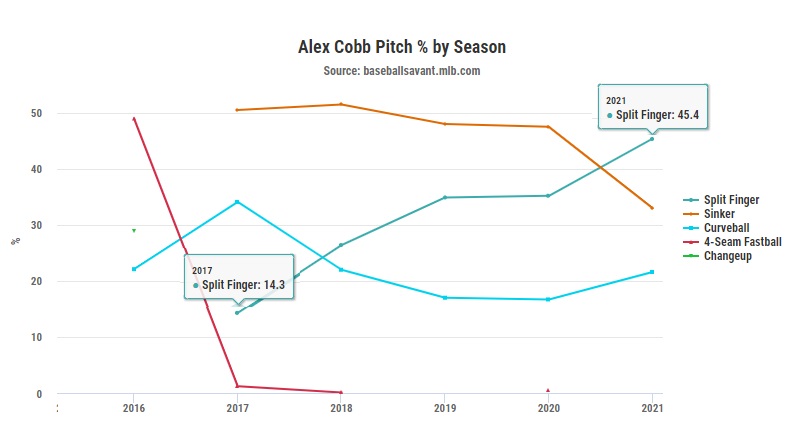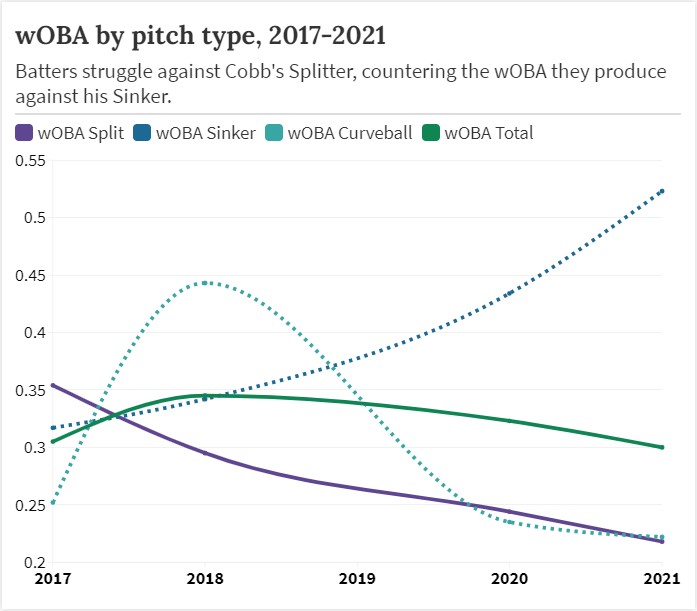Did you ever see this a couple of years ago?
https://gfycat.com/hilariousglossydogwoodclubgall
I bet you did, occasionally, especially if you are an Orioles fan. Well, that’s Bad Cobb.
Now, did you see this, early this season?
https://gfycat.com/waterloggedlimphummingbird
Yep, that’s Good Cobb.
So, besides the different uniforms and results, what’s the underlying difference between Bad Cobb and Good Cobb?
It’s The Thing, of course.
The Thing
The Thing is Alex Cobb’s split-finger fastball; it is the pitch he mastered when he struck out ten Royals, while allowing three earned runs in 5.2 innings, during his second start this season. Seven out of those ten strikeouts were sealed with The Thing, all of them whiffs.
Cobb’s use of the splitter is nothing new, he has thrown it since 2017, when he started using it almost 15% of the time, as we can see in the following pitch mix graph:

He increased the use of it in 2018 and 2019, keeping it steady until 2020 at 35%, he also used his sinker at 48% and the curveball 17% of the time, last season. And then, it looks like Cobb realized something: The Thing actually works! In fact, it looks like he found a way to make it work, and the results are showing themselves:

2019 data points are omitted due to Cobb pitching only 12.1 innings that year.
As you can see in the graph, which doesn’t include last night’s start (more on that later), Cobb’s fate goes as his splitter goes. Since last year, he has continuously increased its usage (45%, this season), and he is getting better and better results: while his sinker keeps getting pounded (wOBA against it keeps going up, look at the rising dashed blue line in the graph), he’s been able to use the splitter to minimize the damage from batters (solid descending purple line).
Early last season, it was already noted that he was getting more tilt from the splitter, while his command of the pitch had also improved, and earlier this year, Eno Sarris noted that “getting his splitter back”, made Cobb an above-average pitcher in Quality of Stuff Plus (QoS+) and Command+.
All of this is particularly important because splitters are unpredictable and require a level of finesse. They can yield a lot of whiffs because, when well executed, it tunnels wonderfully with other pitches, like we can see in the following “Master Splitter” Shohei Ohtani overlay, by @PitchingNinja:
Shohei Ohtani, 97mph Fastball (foul) and 91mph Splitter (Swinging K), Overlay. pic.twitter.com/QutPymX9VX
— Rob Friedman (@PitchingNinja) April 21, 2021
All in all, it’s definitely clear that it’s the splitter that, when working, makes Cobb go from Bad to Good and vice-versa. That leads us to last night’s start when he was very bad: 2.2 IP, 4 ER, 3 BB, and 4 SO. He threw 79 pitches and only 47 strikes. So, what was the difference between Thursday’s game and the first two starts? It all goes back to The Thing.

While in the first two starts his overall CSW% was 34%, this time around he could only manage a poor 24%. His CSW% for the splitter went from 36.4% to a miserable 12%. Obviously, it was not working at all, leaving the whole weight on the curveball, which performed excellently (47% CSW%) but it’s difficult to succeed with only one pitch working unless you are a healthy Dinelson Lamet.
Also, he was not getting enough whiffs from the splitter, and its location was erratic, as you can see here:

He was not hitting the Zone consistently and also, pitches were tending to drop more than before; Bad Thing, Bad Cobb.
Now, what can the first two successful 2021 starts show about what could be expected for the rest of the season?
This is a pretty interesting question as pitchers like Cobb defy the traditional analysis because of their perennial lack of consistency. Let’s take a look (we will ignore last night’s numbers for the following charts, but we will bake them in as part of the general analysis):
| Name | IP | K-BB% | pCRA | CSW% | O-Swing%+Zone% | speX |
|---|---|---|---|---|---|---|
| Alex Cobb | 11.2 | 30.6 | 3.37 | 32.5 | 80.2 | 85.19 |
We should not get too excited about this K-BB% since his career average is 12%, way lower than that 30.6%. If we check from mid-2020 to the present, it raises to 16.3%, still low for these days’ standards but it shows that he is steadily improving it.
Also, his O-Swing% + Zone% and CSW% for that period are 75.3% and 29.2% against his career average of 74.4% and 27.7% respectively, small but good steps forward.
To better gauge what he’s done so far this year, let’s take a look and compare with pitchers with a similar performance to begin the year:
| Rk | Pitcher Name | IP | speX | K-BB% | pCRA | O-Swing% + Zone% | CSW% |
|---|---|---|---|---|---|---|---|
| 7 | Trevor Bauer | 26 | 88.02 | 31.25 | 3.09 | 76.5 | 33.7 |
| 8 | Lance Lynn | 19.2 | 86.73 | 32.47 | 3.13 | 82.8 | 28.1 |
| 9 | Alex Cobb | 11.2 | 85.20 | 30.61 | 3.37 | 80.2 | 32.5 |
| 10 | Max Scherzer | 19 | 83.37 | 30.43 | 3.52 | 72.8 | 32.1 |
| 11 | Tyler Mahle | 14 | 83.34 | 26.79 | 3.32 | 71.8 | 33.2 |
It’s true that it’s very early, and it’s true that Cobb has the smallest quantity of innings pitched of the lot, but nevertheless, this is a really nice tier to be in. While it is really improbable that Cobb can sustain the K-BB% and CSW% numbers, the most interesting part is the way he is commanding his pitches and keeping them in the strike zone when needed (Zone%) while still managing to make batters chase them (O-Swing%); from this group, only Lance Lynn has a higher O-Swing% + Zone%, and if this keeps trending like this, he will be able to sustain some of the growth in the other stats we’ve seen so far, as this is the way he is getting whiffs and called strikes.
Another important aspect so far has been how his adjustments have influenced the quality of the contact that batters are achieving against his pitches:
| Name | Season | BBE | HH% | DHH% | Blast% | Barrel% | Solid% | Flare% | Poor% | GB% | LD% | FB% | PU% |
|---|---|---|---|---|---|---|---|---|---|---|---|---|---|
| Alex Cobb | 2020 | 168 | 48.5% | 13.8% | 3.6% | 9.5% | 8.3% | 27.4% | 54.2% | 48.0% | 19.8% | 23.0% | 9.3% |
| Alex Cobb | 2021 | 29 | 42.9% | 17.9% | 3.4% | 6.9% | 0.0% | 34.5% | 58.6% | 55.6% | 14.3% | 20.6% | 9.5% |
| League Average | 2021 | 41.0% | 16.0% | 4.4% | 8.6% | 6.2% | 24.0% | 60.8% | 33.9% | 16.9% | 28.5% | 20.7% |
Almost every important contact metric declines when Cobb is “feeling” his splitter, and although this is a very small sample, it is worth noting.
In that regard, it is extremely difficult to anticipate when Cobb will be having the best command or “feel” on his splitter, so we can’t really anticipate when is it better to start him, but we can work with the odds by using the following rule of thumb: as splitters are way more effective when they fall as close as possible to the strike zone without really getting into the zone (in the boundaries of the chase area), we can increase the probabilities of getting better results playing him against teams with O-Swing% higher than the league average (30.4% at this moment) as it was the case in first to starts against the White Sox (34%) and the Royals (34.5%). The Angels were closer to the average, at 31.4%. This is not set on stone, of course, but lacking better options is a good guesstimate. Later on, as we move into the season, the data will be better and more abundant in this sense.
What we’ve seen so far from Cobb makes me feel optimistic in terms of what he is capable of doing rest of the season; even accounting for the occasional disastrous start in which he won’t master the splitter, it certainly looks like he can reach a level of comfort with it, good enough to make it a truly effective weapon against the opposing batters and I don’t see reasons to see him out of being a solid SP3-SP4 option with high upside, rest of the way.
Photos by Scott Winters and Frank Jansky/Icon Sportswire | Adapted by Jacob Roy (@jmrgraphics3 on IG)


Do you like Cobb over guys like M.Fulmer, R.Ray, D.Smyly, Elieser Hernandez, Turnbull, J.Montgomery?
Hi, friend! I guess I’d prefer him over Fulmer, Smyly, Turnbull and Motgomery. I’d still have Hernández and Ray over him, in that order.
Here’s what I said to Nick’s review:
I don’t want to argue that Cobb pitched well yesterday, but I strongly feel he was victimized by numerous bad pitch calls (strikes called balls) and out-of-position players, for what should have been outs (EG: Straw’s triple should have been a ground out to third). I think this falls under just-one-of those-games, not that Cobb hasn’t turned the corner. Eventually those things began to snowball. My biggest question was why he didn’t throw his knuckle-curve more, which was throwing people off-balance.
Hi! I am with you almost 100% there; he had some bad luck yesterday, that’s why while his ERA for the game was 13.50, his FIP was 4.60. I’m not totally freeing him of responsibility (the CSW on the splitter is damning) but I will close one eye.